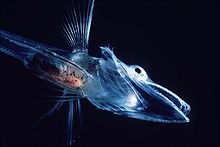Notothenioidei
| Antarctic icefish | |
|---|---|

| |
| An icefish off the coast of Antarctica. | |
| Scientific classification | |
| Kingdom: | |
| Phylum: | |
| Class: | |
| Order: | |
| Suborder: | Notothenioidei
|
| Families | |
|
Bovichtidae | |
Notothenioidei is one of 18 suborders from the order Perciformes and includes Antarctic icefish and sub-Antarctic fish. Notothenioids are distributed mainly throughout the Southern Ocean around the coasts of New Zealand, South America, and Antarctica. The main seawater temperatures between −2 and 4 °C (28 and 39 °F), but some the subpolar species inhabit waters that may be as warm as 10 °C (50 °F) around New Zealand and South America. Seawater temperatures below the freezing point of fresh water (0 °C or 32 °F) are possible due to the dissolved salts.
Notothenioids have a depth range of about 0–1,500 m (0–4,921 ft).
Comparison studies between sub-Antarctic and Antarctic notothenioids have revealed different ecological processes and genetic differences between the two groups of fish, like loss of hemoglobin and changes in buoyancy.
Anatomy
This section includes a list of references, related reading, or external links, but its sources remain unclear because it lacks inline citations. (January 2015) |
The notothenioids lack a swimbladder, and the majority of species are therefore benthic or demersal in nature. However, a depth-related diversification has given rise to some species attaining increased buoyancy, using lipid deposits in tissues and reduced ossification of bony structures. Reduced ossification of the skeleton in the notothenioids changes their weight and henceforth has created neutral buoyancy in the water, where the notothenioid neither sinks nor floats, and can thus adjust depth with ease.
Notothenioids have evolved a variety of interesting physiological and biochemical adaptations that either permit survival in, or are possible only because of, the generally cold, stable seawater temperatures of the Southern Ocean. Many notothenioid fish are able to survive in the freezing, ice-laden waters of the Southern Ocean because of the presence of an antifreeze glycoprotein in blood and body fluids. Although many of the Antarctic species have antifreeze proteins in their body fluids, not all of them do. Some subpolar species either produce no or very little antifreeze, and antifreeze concentrations in some species are very low in young, larval fish.
While the majority of animal species have up to 45% of hemoglobin (or other oxygen-binding and oxygen-transporting pigments) in their blood, the notothenioids of the family Channichthyidae have only 1%. They can still flourish in part because of the high oxygen content of the cold waters of the Southern Ocean and in part because oxygen is absorbed and distributed directly by the plasma. These fish must expend twice as much energy in cardiac output per second than the notothenioids with higher hemoglobin concentration. At a cold temperature, oxygen solubility is greatly increased.
Classification
This classification follows Eastman and Eakin, 2000.[1]
- Family Bovichtidae
- Genus Bovichtus (nine species, eight non-Antarctic)
- Genus Cottoperca (one species, non-Antarctic)
- Family Pseudaphritidae
- Genus Pseudaphritis (one species, non-Antarctic)
- Family Eleginopsidae
- Genus Eleginops (one species, non-Antarctic)
- Family Nototheniidae
- Genus Aethotaxis (one species)
- Genus Cryothenia (two species)
- Genus Dissostichus (two species)
- Genus Gobionotothen (four species)
- Genus Gvozdarus (one species)
- Genus Lepidonotothen (six species, one non-Antarctic)
- Genus Notothenia (five to seven species, two to three non-Antarctic)
- Genus Pagothenia (two species)
- Genus Paranotothenia (two species)
- Genus Patagonotothen (14 species, all non-Antarctic)
- Genus Pleuragramma (one species)
- Genus Trematomus (11 species)
- Family Harpagiferidae
- Genus Harpagifer (six species)
- Family Artedidraconidae
- Genus Artedidraco (six species)
- Genus Dollodidraco (one species)
- Genus Histiodraco (one species)
- Genus Pogonophryne (22 species)
- Family Bathydraconidae
- Genus Acanthodraco (one species)
- Genus Akarotaxis (one species)
- Genus Bathydraco (five species)
- Genus Cygnodraco (one species)
- Genus Gerlachea (one species)
- Genus Gymnodraco (one species)
- Genus Parachaenichthys (two species)
- Genus Prionodraco (one species)
- Genus Psilodraco (one species)
- Genus Racovitzia (one species)
- Genus Vomeridens (one species)
- Family Channichthyidae
- Genus Chaenocephalus (one species)
- Genus Chaenodraco (one species)
- Genus Champsocephalus (two species)
- Genus Channichthys (nine species)
- Genus Chionobathyscus (one species)
- Genus Chionodraco (three species)
- Genus Cryodraco (one species)
- Genus Dacodraco (one species)
- Genus Neopagetopsis (one species)
- Genus Pagetopsis (two species)
- Genus Pseudochaenichthys (one species)
- Genus Brulenthius (one species)
References
- ^ J. T. Eastman & R. R. Eakin (2000). "An updated species list for notothenioid fish (Percifomes; Notothenioidei), with comments on Antarctic species" (PDF). Arch. Fish. Mar. Res. 48 (1): 11–20.
Further reading
- Macdonald, J. A. (2004). "Notothenioidei (Southern Cod-Icefishes)". In M. Hutchins, R. W. Garrison, V. Geist, P. V. Loiselle, N. Schlager, M. C. McDade, ...W. E. Duellman (Eds.), Grzimek's Animal Life Encyclopedia (2nd ed., Vol. 5, pp. 321–329). Detroit: Gale.
